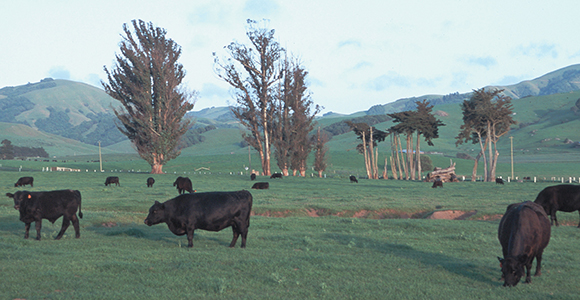
Rangeland grazing in Sonoma County (Photo Credit: USDA)
To accelerate California’s policy leadership in the face of global crises like water scarcity, climate change and uneven economic development between urban and rural areas, it is essential to recognize of the importance of the state's natural capital, especially in relation to working landscapes and rural economies.
The California Economic Summit defines working landscapes to include farmland, ranches, forest, wetlands, mines, water bodies and other natural resource lands, both private and public. Carbon is the energy currency of most biological systems, including agricultural ecosystems. All agricultural production originates from the process of plant photosynthesis, which uses sunshine to combine carbon dioxide (CO2) from the air with water and minerals from the soil to produce plant material, both above and below ground.
Agriculture is the ONE sector that can transform from a net emitter of CO2 to a net sequestered of CO2.
There is no other human-managed realm with this potential. Common agricultural practices, including driving a tractor, tilling the soil, grazing, result in the return of CO2 to the air. However, all farming is “carbon farming” because all agricultural production depends upon plant photosynthesis to move carbon dioxide out of the atmosphere and into the plant, where it is transformed into agricultural products, whether food, flora, fuel or fiber.
Agriculture contributes only 9 percent of the carbon dioxide emissions in the US (EPA); and agricultural landscapes, particularly grassland/rangelands, have great potential to function as a sponge for carbon dioxide from our atmosphere. The maximum capacity of soil to store organic carbon is determined by soil type (percent clay); management practices implemented to maximize plant growth and minimize losses of organic carbon from soil can increase organic carbon storage in soil. Keeping working lands “working” can result in long-term carbon storage (decades to centuries or more) in soils.
Rangelands:
There is a growing body of work suggesting that significant amounts of carbon can be stored in soil. This is particularly true on rangelands, which house approximately 30 percent of terrestrial carbon stocks in addition to a substantial amount of aboveground carbon in trees, plants and grasses, and can hold carbon over longer periods of time (FAO, 2009; Flynn, A., et al., 2009; White, R., et al., 2000). Management of rangelands, through grazing, can lead to increased forage production, longer growing seasons and a potential conversion to a perennial system. Grazing stimulates plant growth through a variety of mechanisms, resulting in increased carbon capture by the grazed ecosystem. The potential to increase the amount of carbon held in rangeland ecosystems or to minimize losses of existing carbon offer landowners an opportunity to manage their lands in ways that contribute to climate change mitigation by encouraging carbon sequestration. This can be done by increasing carbon inputs and uptake, decreasing or preventing carbon releases, or both. Given that there are 57 million acres of rangeland in California alone, and that rangeland is the largest land type on our planet today, these practices can make a significant contribution to carbon sequestration.
How to increase carbon stored:
An approach known as “Carbon Farming” involves implementing practices that are known to improve the rate at which CO2 is removed from the atmosphere and converted to plant material and/or soil organic matter. Carbon farming is successful when carbon gains resulting from enhanced land management and/or conservation practices exceed carbon losses. These practices increase the amount of photosynthetically captured carbon held, or “sequestered”, in long-term carbon pools on the farm or ranch, including soil organic matter, perennial plant roots and standing woody biomass. This results in a direct reduction of carbon dioxide in the atmosphere.
Expanding Carbon Markets:
Expanding investment in programs that support carbon sequestration in soil, such as the Healthy Soils Program, can create stronger financial incentives for ranchers to implement these practices (De Gryze, S., et al., 2009). Moreover, given the well-established relationship between soil organic matter (of which an average of 50 – 56 percent is carbon) and the ability of soils to retain water (Huntington, 2007; Pribyl, 2010; Rawls et al., 2003), such a market could contribute to watershed function, natural groundwater recharge and overall water provision.
The scientific consensus surrounding the relation between greenhouse gas (GHG) emissions and global climate change has indicated a clear need for the U.S. to find new ways to reduce emissions of these gases and the concentrations in the atmosphere to avoid significant and potentially catastrophic environmental changes. Land management for carbon sequestration is one of many opportunities available to the U.S., more locally in California, to reduce their net emissions of GHGs, particularly CO2. Carbon-oriented management of working landscapes may offer landowners the opportunity to obtain a new source of income while simultaneously helping to mitigate climate change. The payment for ecosystem services, such as carbon sequestration, may be a potential solution to climate change.
The value of California's natural capital will be an important part of the conversations at the 2017 California Economic Summit taking place in San Diego on November. Solutions like improving the state's ecosystem services management represent ways to boost California's triple bottom line: simultaneous growth in the economy, improvement in environmental quality, and increased opportunity.
Stephanie Larson is director of University of California Cooperative Extension, Sonoma County; and Adam Livingston is director of planning and policy at the Sequoia Riverlands Trust

